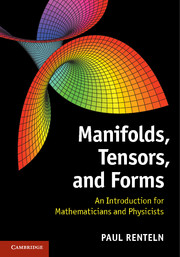Book contents
- Frontmatter
- Contents
- Preface
- 1 Linear algebra
- 2 Multilinear algebra
- 3 Differentiation on manifolds
- 4 Homotopy and de Rham cohomology
- 5 Elementary homology theory
- 6 Integration on manifolds
- 7 Vector bundles
- 8 Geometric manifolds
- 9 The degree of a smooth map
- Appendix A Mathematical background
- Appendix B The spectral theorem
- Appendix C Orientations and top-dimensional forms
- Appendix D Riemann normal coordinates
- Appendix E Holonomy of an infinitesimal loop
- Appendix F Frobenius' theorem
- Appendix G The topology of electrical circuits
- Appendix H Intrinsic and extrinsic curvature
- References
- Index
3 - Differentiation on manifolds
Published online by Cambridge University Press: 05 June 2014
- Frontmatter
- Contents
- Preface
- 1 Linear algebra
- 2 Multilinear algebra
- 3 Differentiation on manifolds
- 4 Homotopy and de Rham cohomology
- 5 Elementary homology theory
- 6 Integration on manifolds
- 7 Vector bundles
- 8 Geometric manifolds
- 9 The degree of a smooth map
- Appendix A Mathematical background
- Appendix B The spectral theorem
- Appendix C Orientations and top-dimensional forms
- Appendix D Riemann normal coordinates
- Appendix E Holonomy of an infinitesimal loop
- Appendix F Frobenius' theorem
- Appendix G The topology of electrical circuits
- Appendix H Intrinsic and extrinsic curvature
- References
- Index
Summary
When in doubt, differentiate.
Shing-Shen Chern (1979).
Raoul Bott (1982).The idea of a differentiable manifold had its genesis in the nineteenth century with the work of Carl Friedrich Gauss and of Georg Friedrich Bernhard Riemann. Gauss was interested in surveying and cartography, which led him to develop the tools of calculus on curved surfaces. His famous theorema egregium, or remarkable theorem, revealed that one could consider the intrinsic properties of a surface independently of the way in which it was embedded in three-dimensional space, and this led him, Riemann, and others, to abstract these concepts even further. Their ideas have had far reaching applications in many areas of mathematics and the natural sciences.
Roughly, an n-dimensional manifold (or n-manifold) can be thought of as a kind of patchwork quilt built from pieces of ℝn. Classic examples of 2-manifolds are the 2-sphere S2 and the 2-torus T2 (see Figure 3.1). Usually one pictures these as living in ℝ3, but one can consider them in their own right just as bits of ℝ2 sewn together in certain ways. The technical definition of a manifold requires considerable background, which we will try to keep to a minimum. First, we need the idea of a topology.
Basic topology*
Consider a basketball. When it is inflated, its surface is a sphere. But when it is deflated its surface is still a topological sphere.
- Type
- Chapter
- Information
- Manifolds, Tensors, and FormsAn Introduction for Mathematicians and Physicists, pp. 54 - 115Publisher: Cambridge University PressPrint publication year: 2013



